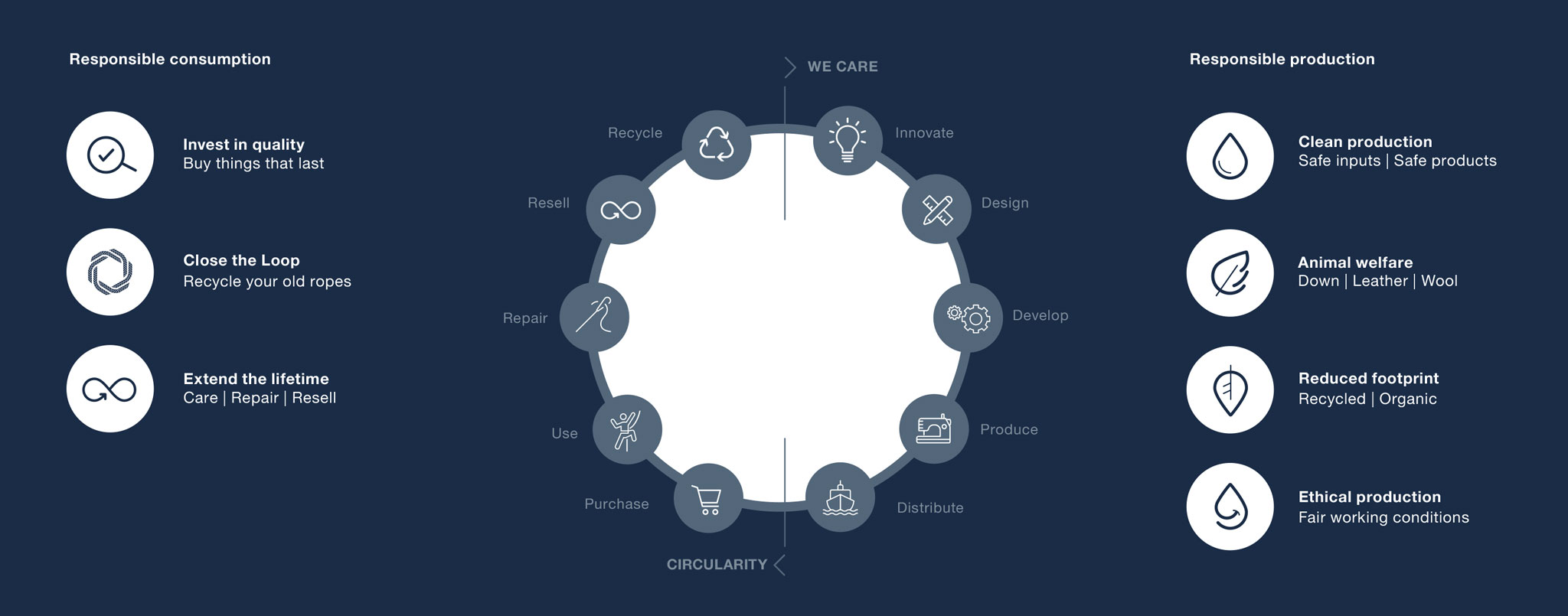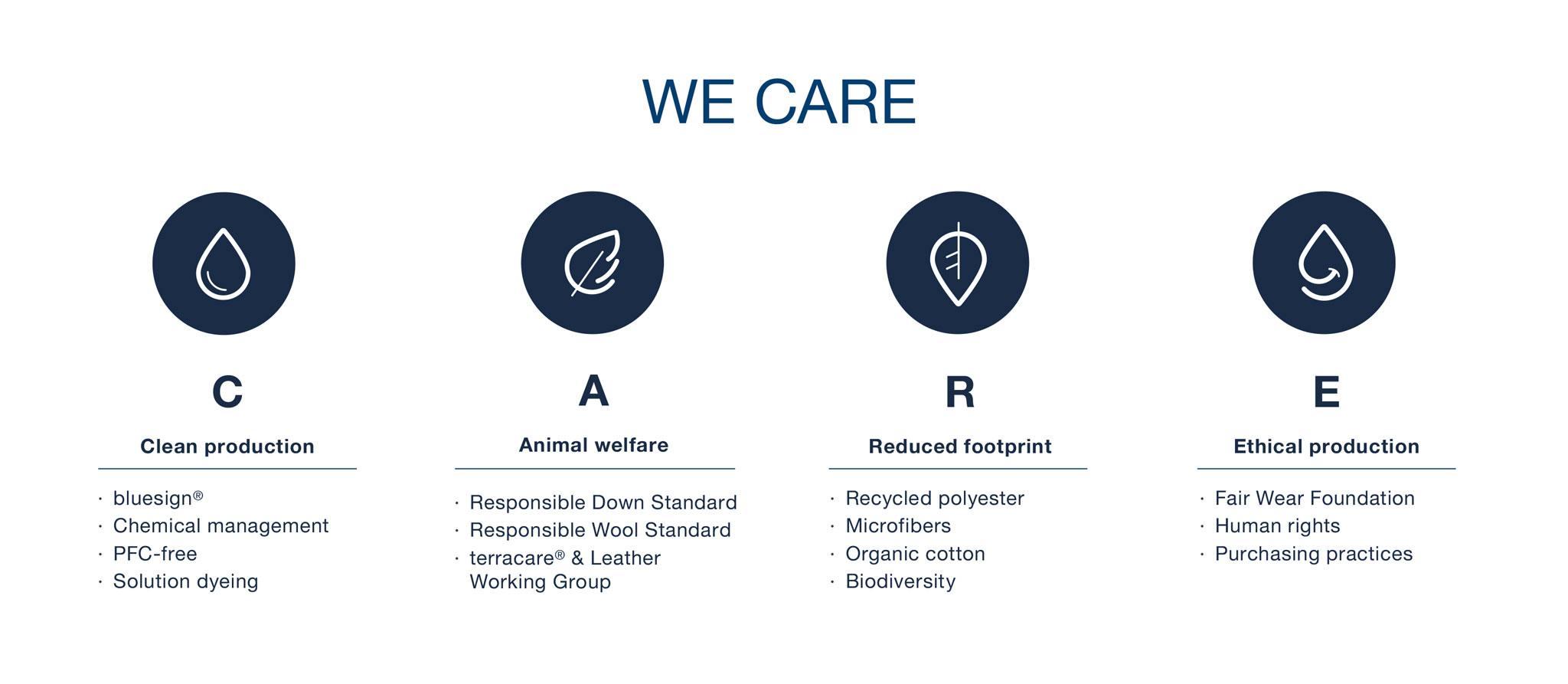MAMMUT 2021 RESPONSIBILITY REPORT
Press Release | With the 2021 Responsibility Report, Mammut presents its first comprehensive Responsibility Report, covering social and environmental topics. As a driver in the industry, Mammut has led with integrity for 160 years, creating transparency, striving to advance measurable positive change that will last over time, and inspiring the same spirit in its consumers, communities, and the industry around the world.
August 9, 2022

Since 2006, Mammut has been driving the issue of sustainability together with other industry players like Patagonia. The first comprehensive Responsibility Report shares the work Mammut has done and highlights everything from industry initiatives to pilot projects and challenges that Mammut and the industry have faced along the way.
Responsibility Journey

Over the past two decades, international supply chain challenges have been addressed through collaborations with industry experts, external monitoring systems and partners, including Fair Wear Foundation and bluesign®. As a primary signatory of the UN’s Fashion Industry Charter for Climate Action in 2018, Mammut put the climate crisis on the top of its strategic agenda.
In addition to industry collaborations and accreditations, Mammut engages in political discussions such as the Swiss Glacier Initiative and the CO2 bill. Further, the company is a member of swisscleantech, an association connecting government with business to improve sustainability practices. Mammut believes in the importance and power of teamwork and community, on and off the mountains. For this reason, Mammut is teaming up with strong partners in a wide variety of areas, such as Protect Our Winters, ClimbAID, and many more. Together, the goal is to achieve positive change with a clear strategy.
Climate Strategy: Do our best – remove the rest
Due to the global climate crisis the environment is changing. Mammut as an organization embraces the responsibility to respond. The climate strategy “do our best, remove the rest” drives Mammut to focus on tangible, progressive climate action and measurable carbon removal solutions, whether that be with nature-based, technological, or hybrid approaches. Having signed the Paris Agreement’s UN Fashion Industry Charter for Climate Action, Mammut commits to reaching Net zero by 2050. To take part in limiting global warming to 1.5 °C above pre-industrial levels, Mammut has set verified science-based targets and identified measures to decarbonize the value chain significantly. Mammut’s goal is to halve the greenhouse gas emissions by 2030 compared to 2018 (baseline year). This requires Mammut to challenge every area of its current business practices.
- Power operations and source from factories using renewable energy
- Increase the use of lower-impact materials and production processes
- Rethink how to move products around the world
- Ensure products last longer and can be easily repaired
- Explore alternative circular business models
- Engage consumers and support stronger regulations to accelerate policy change

To tackle these global challenges together, Mammut is aware that it is essential to have a common understanding of the issue of sustainability and the resulting courses of action. So, if the terms Net zero, climate neutrality, or “do our best – remove the rest” are still not clearly separable and tangible: Go check this out: Net-zero emissions: do our best – remove the rest .
Targets and Scopes

Mammut calculates its carbon footprint according to the Greenhouse Gas Protocol (GHG Protocol), a leading standard for analyzing an organization’s emissions. It distinguishes between three scopes, which can then be used to clearly define emission targets and strategies.
- Scope 1 accounts for emissions from facilities and tools Mammut owns or controls, including company cars and technical equipment at its own locations.
- Scope 2 addresses indirect emissions such as electricity, heating, and cooling purchased by the organization.
- Scope 3 is the largest and most challenging category, involving all production and post-sales emissions, ranging from unused materials during manufacturing and employees commuting, to the product treatment at end-of-life. Building more sustainable supply and value chains will significantly impact Scope 3 emissions. This is why Mammut’s climate strategy focuses on upstream and downstream activities.
Circularity & Services
Mammut is focusing its efforts on all scopes. Here are some examples to illustrate this:

We CARE
Mammut Team members defined the WE CARE framework and goals to create more durable and ethical products, which are part of a circular economy. While developing the craftsmanship and performance of the materials and products, WE CARE holds Mammut accountable for clean production, animal welfare, reduced footprint, and ethical production.

Longevity, product care & repair
Durability, material quality, and repairability are at the heart of the design process at Mammut. They are essential ingredients for products to be long-lasting and sturdy companions in the outdoors. The long-term use of outdoor equipment is the easiest way to reduce its environmental footprint.
Regular care of outdoor equipment helps to maintain its performance and safety and prolongs its lifespan, thereby reducing its environmental impact. To support customers, Mammut offers detailed care instruction tutorials for its most popular products, including Hardshell jackets, down jackets, shoes, and ropes.
If an item is damaged, customers in the EU and Switzerland may send it in for repairs at one of Mammut’s in-house studios. In 2021, Mammut mended over 14,000 products in Europe and is aware of 175 third-party repairs in North America and 800 in Japan. Comparing the environmental impact of repairing items to purchasing new products, the repair studios save a large amount of CO2 and water annually.
Close the Loop
Product and resource circularity will play an essential role for Mammut in achieving the 2050 Net zero target. Ropes are central to Mammut’s brand DNA and history. Yet, in terms of environmental impact, they present a serious challenge, as their production accounts for over ten percent of Mammut’s annual carbon footprint. To address this, Mammut piloted the Close the Loop project in Switzerland in 2020, creating a more circular business model. Established with the help of Protect Our Winters Switzerland and climbing gyms, the take-back program collects used climbing ropes, which are then recycled and used in new products, primarily shirts. Since the project`s launch, Mammut has prevented over 3,500 kg of rope from going into landfill or incineration.
Close the Loop in numbers:
- 50 – rope collection points in Switzerland
- 67% – CO2 saved compared to a regular T-shirt
- 100% – recycled material
The goal is to design a rope-to-rope recycling program. However, with current technologies, the yarn created is not yet sufficient for the safety demands of a climbing rope.
In 2021, the Close the Loop pilot was honored with the ISPO Gold Award and the German Award for Sustainability Projects. Mammut is currently in the process of expanding the Close the Loop project and setting up climbing rope take-back programs in fourteen other European countries.
Hungry to learn more? Inspired to be part of this positive change? Check out the full CR Report and get in touch with us. We'll be happy to provide more information, address specific topics, or connect you with our experts.
DOCUMENTS FOR DOWNLOAD
Mammut Press Release Responsibility Report.pdf
PDF - 522 Kb
Mammut Responsibility Report 2021.pdf
PDF - 9.1 Mb